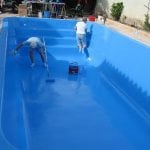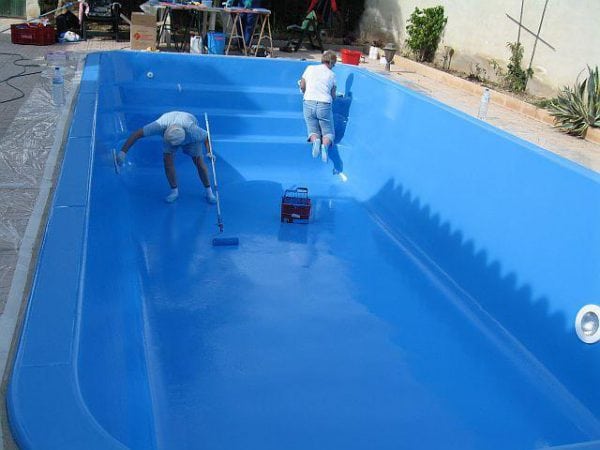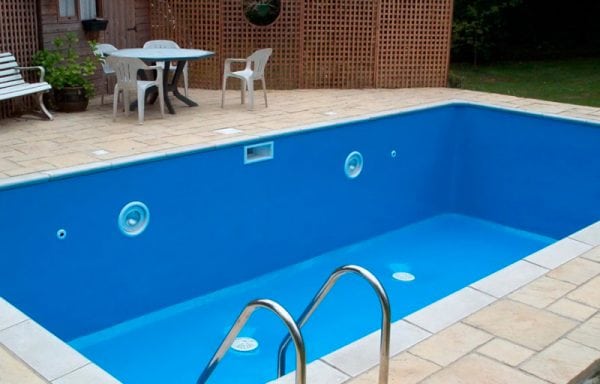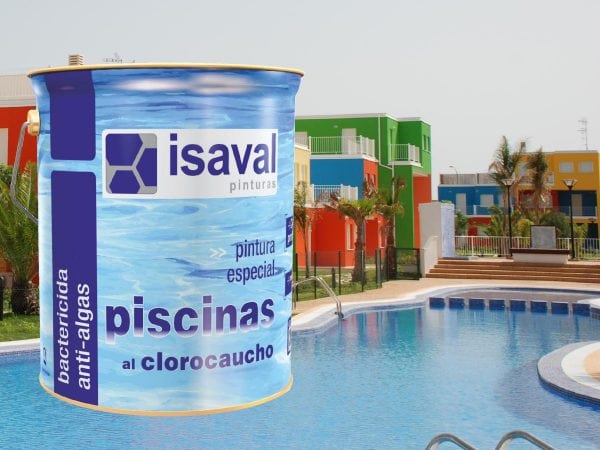Well, your pool has been dug up, high-quality waterproofing has been carried out, and it is ready to have paint for the pool. Let's talk about how and how to process a pool made of concrete or metal.
- Characteristics and properties of the composition
- Latex paint process
- Concrete pool painting technology

When choosing, you need to pay close attention to the characteristics and composition of the paint based on latex components. Because it will constantly come in contact with water, temperature differences will occur, it will be exposed to ultraviolet rays, chemical detergents, and also not break the bond (adhesion) to the base and not lose its original color.

The rubber composition used for painting the reservoir, has remarkable qualities during operation. In texture, it more likely looks like a mastic, and after hardening, a rubber elastic film is created on the base of the pool.
to contents ↑Characteristics and properties of the composition
- excellent adhesive quality (adhesion) and waterproofing, perfectly covers various areas and materials used in the manufacture of pools (concrete, metal);
- resistant to temperature extremes (not afraid of severe frosts and high heat) and the effects of the atmosphere, to any mechanical stress and ultraviolet;
- composition with rubber hardens very quickly, within one to two hours;
- easy to use, you only need to have a brush or a roller; spray cans of paint have been relevant lately;
- the surface is not slippery at all, reduced trauma;
- long term of operation (8-10 years);
- rubber for pools does not contain hazardous substances, is completely safe, does not cause allergic reactions, provides protection against the appearance of fungi and mold;
- when dried, it acquires the properties of flexibility and extensibility, has a pleasant and velvety texture.
In the manufacture of rubber-based paints, manufacturers use the following components: five percent water (solvent), acrylate rubber, which gives strength and elasticity properties, a plasticizer for film formation (coalescent), antifreeze liquid (frost resistance property), preservatives (for storing the composition, it does not fungus and mold), various additional substances (fillers, coloring pigments).

Latex paint process
- When laying the paint with chlorinated rubber, the metal surface must be cleaned from rust and grease, the concrete base must be primed, if the surface was previously painted with alkyd or oil paint, wash with soda or phosphate-sodium compound.
- Carry out a test painting with a rubber compound to determine the density, color and drying time.
- The rubber composition is applied to the base in several thin layers at intervals of a couple of hours to increase wear resistance.
Chlorinated rubber paint for swimming pools is considered the most common for painting the surfaces of pools and artificial ponds, is available in a wide range of colors, and also has a low cost.
However, if you decide to paint your pool with elastomer-based paint, you need to carefully select the coloring rubber composition, bring the pond into proper shape, carefully study the instructions for use.

If you choose the right materials, spend a little of your time and make a little effort, you will get a completely transformed pool without spending a lot of finance. To do this, you will need such materials and tools - paint with rubber, paint containers, a large-sized roller (wide), brushes, protective gloves and glasses, a cleaner, scrapers, a metal brush, 3 sodium phosphate.
to contents ↑Concrete pool painting technology
- Get chlorinated rubber paint at a building materials store.
- Remove water, various debris and pollution from the reservoir.
- Clean the concrete surface with a metal brush and a scraper from old paint, remove all dust, rinse the entire surface of the pool with a 50% acid composition, rinse with clean water.
- To neutralize the acid composition, treat the pool with 3-sodium phosphate solution, degrease the surface, rinse again with clean water.
- Putty all defects (cracks, holes) with cement mortar.
- Be sure to let the entire surface dry.
- Lay the paint on the basis of elastomers with a wide roller, starting from the deepest place, rising to the top, with a brush paint over inaccessible places (valves, light fixture, drainage).
- Paint with rubber should dry for a period of time specified in the manufacturer's instructions, because it is necessary for reliable and durable fixation (approximately 3-5 days).
- Fill your newfound pool with water, and change the filter settings for service.
Additional recommendations:
- without fail, thoroughly mix the coloring composition before use;
- do not work when it is very hot, cold or high humidity (surface adhesion may occur);
- impose the composition in the thinnest layer so that no bubbles appear;
- When working with acidic detergent mix, be sure to use safety glasses and gloves.
Paint for coloring pools with the content of elastomers is an optimal and ideal choice.You no longer have to redo your pond every few years, because such a material has durability and reliability. And there is no need to worry that your pool will let water through.




Good afternoon! Please tell me about the paint for pools !! We have a PVC film, how can it be painted and is it even possible ??
Read the article PVC paint
Hello! I have a frame pool for seven years. installed it last summer, poured water, and a lot of small holes appeared in the rubber, in general, it leaks. I taped them as best I could. rubber is not the same and decided to paint, now I choose which one. Question: if I paint the rubber of the pool with polyurethane paint, will it turn out like a new coating or will there be no result in my case? And if you paint what paint?